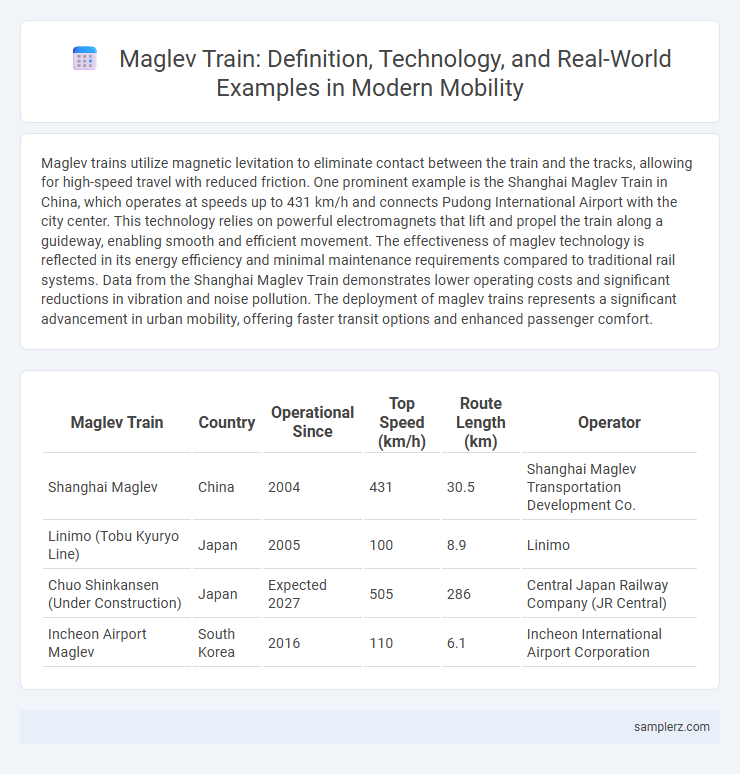Maglev trains utilize magnetic levitation to eliminate contact between the train and the tracks, allowing for high-speed travel with reduced friction. One prominent example is the Shanghai Maglev Train in China, which operates at speeds up to 431 km/h and connects Pudong International Airport with the city center. This technology relies on powerful electromagnets that lift and propel the train along a guideway, enabling smooth and efficient movement. The effectiveness of maglev technology is reflected in its energy efficiency and minimal maintenance requirements compared to traditional rail systems. Data from the Shanghai Maglev Train demonstrates lower operating costs and significant reductions in vibration and noise pollution. The deployment of maglev trains represents a significant advancement in urban mobility, offering faster transit options and enhanced passenger comfort.
Table of Comparison
| Maglev Train | Country | Operational Since | Top Speed (km/h) | Route Length (km) | Operator |
|---|---|---|---|---|---|
| Shanghai Maglev | China | 2004 | 431 | 30.5 | Shanghai Maglev Transportation Development Co. |
| Linimo (Tobu Kyuryo Line) | Japan | 2005 | 100 | 8.9 | Linimo |
| Chuo Shinkansen (Under Construction) | Japan | Expected 2027 | 505 | 286 | Central Japan Railway Company (JR Central) |
| Incheon Airport Maglev | South Korea | 2016 | 110 | 6.1 | Incheon International Airport Corporation |
Introduction to Maglev Technology in Modern Railways
Maglev technology, using magnetic levitation, enables trains to float above tracks, eliminating friction and allowing speeds exceeding 600 km/h, as demonstrated by the Shanghai Maglev in China. Modern railways leverage superconducting magnets and precision guidance systems to achieve smooth, energy-efficient, and low-maintenance operation. This innovation revolutionizes urban and intercity transit by significantly reducing travel time and operational costs.
How Maglev Trains Redefine High-Speed Mobility
Maglev trains utilize magnetic levitation technology to eliminate wheel-rail friction, enabling speeds exceeding 600 km/h with remarkable energy efficiency. The absence of physical contact reduces maintenance costs and allows for smoother, quieter rides compared to conventional high-speed trains. High-speed maglev systems like Japan's SCMaglev and China's Shanghai Maglev Line exemplify how this technology redefines rapid, sustainable urban and intercity mobility.
The Shanghai Maglev: World’s Fastest Commercial Maglev Train
The Shanghai Maglev, reaching speeds up to 431 km/h (268 mph), stands as the world's fastest commercial maglev train, utilizing magnetic levitation technology to eliminate friction and ensure smooth, rapid transit between Shanghai Pudong Airport and the city center. Operating on a 30-kilometer track, the train dramatically reduces travel time to just 7 minutes, showcasing the efficiency and innovation in modern urban mobility solutions. This pioneering maglev system exemplifies advancements in high-speed rail transport, setting benchmarks in speed, energy efficiency, and passenger comfort.
Japan’s SCMaglev: Pioneering Next-Generation Transportation
Japan's SCMaglev train employs superconducting magnetic levitation technology to achieve speeds exceeding 600 km/h, setting new standards in high-speed rail transport. This cutting-edge system reduces friction by levitating the train above the tracks, enabling unparalleled acceleration and energy efficiency. SCMaglev's advanced magnetic propulsion and precise control mechanisms exemplify next-generation mobility solutions transforming intercity travel.
Transrapid in Germany: The Evolution of Magnetic Levitation
The Transrapid system in Germany exemplifies advanced maglev technology, utilizing electromagnetic suspension to achieve speeds exceeding 500 km/h with minimal friction. Its evolution highlights innovations in magnetic levitation, enabling smoother, faster, and more energy-efficient train travel compared to conventional rail systems. This pioneering project demonstrates Germany's leadership in high-speed maglev development, influencing global mobility solutions.
Urban Maglev Projects: Enhancing Metropolitan Connectivity
Urban maglev projects such as the Shanghai Transrapid and Japan's Linimo line showcase the potential of magnetic levitation technology to revolutionize metropolitan connectivity by providing ultra-fast, smooth, and efficient transportation within city environments. These systems minimize friction through magnetic levitation, allowing speeds above 100 km/h while reducing noise and maintenance costs compared to traditional rail. Enhanced urban mobility through maglev technology supports sustainable city growth by easing traffic congestion and lowering carbon emissions.
Energy Efficiency and Environmental Impact of Maglev Trains
Maglev trains utilize magnetic levitation to eliminate friction between wheels and tracks, significantly reducing energy consumption compared to conventional trains. These trains achieve energy efficiency by relying on linear motors and regenerative braking systems that recapture energy during deceleration. The environmental impact of maglev technology is substantially lower due to reduced greenhouse gas emissions, decreased noise pollution, and minimal track wear, making it a sustainable solution for modern transportation.
Infrastructure and Challenges in Maglev Implementation
Maglev trains require specialized infrastructure, including elevated guideways equipped with powerful electromagnets and precise control systems to maintain stability and levitation. The high construction costs, need for extensive land acquisition, and integration with existing transportation networks pose significant challenges for widespread implementation. Additionally, addressing electromagnetic interference and ensuring safety standards are critical to the successful deployment of maglev technology in urban and intercity mobility.
Global Case Studies: Successful Maglev Train Systems
Japan's SCMaglev holds the world speed record at 373 mph, demonstrating the efficiency of maglev technology in high-speed rail. China's Shanghai Maglev, operating commercially since 2004, connects Pudong Airport to downtown in just 7 minutes, showcasing practical urban mobility. Germany's Transrapid system, used in limited applications, exemplifies precise engineering and potential scalability for future global transport networks.
Future Prospects: The Role of Maglev in Shaping Urban Mobility
Maglev trains, utilizing magnetic levitation for frictionless travel, offer unprecedented speeds and energy efficiency crucial for future urban mobility. Urban areas adopting maglev technology anticipate significant reductions in traffic congestion and carbon emissions by providing rapid, reliable transit options. Continued advancements in maglev infrastructure and magnet technology will expand accessibility and integration within smart city transportation networks, transforming urban mobility landscapes.

example of maglev in train Infographic
 samplerz.com
samplerz.com